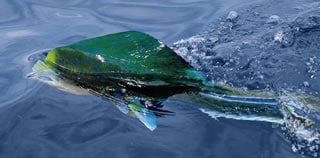
| Dolphin are just one of the many game fish available off Ocean Isle Beach. |
The fishing routine at Ocean Isle Beach is pretty straightforward, but never boring. Each day starts with a trip to the bait store, where everything is free – as long as you’re willing to find and catch it yourself. Some days the search ends quickly, while others require a run along the surf line, scanning for the telltale flip of tails on the surface or diving pelicans. A toss of a large castnet and a few minutes of heavy lifting will fill the live well with palm-sized menhaden.
If the pogies are absent, Plan B is put into effect, which involves jigging pinfish from a ledge or high spot just offshore. Drop a Sabiki rig down, give it a jiggle and you’ve got a batch of lively bait. Just be prepared to suffer the tiny puncture wounds that come with taking them off the hook, because they don’t call ’em pinfish for nothin.’
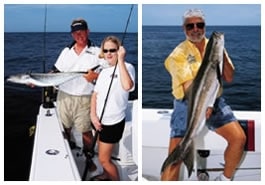
(left) Capt. Brant McMullan and his wife, Amy, teamed up to boat this handsome kingfish. (right) The author displays a cobia that he pulled off a wreck in 60 feet of water.|
Once you’ve got your bait, it’s off to the fishing grounds, and here’s where things get complicated. Why? Because the waters off Ocean Isle hold such a wide variety of game fish that trying to figure out which ones to target can be a challenge in itself.
Overlooked Hot Spot
I had come to this North Carolina resort town to fish with Captain Brant McMullan, his wife, Amy, and his brother, Barrett. Located 20 miles north of Myrtle Beach, Ocean Isle Beach (OIB) faces the Atlantic just south of the Cape Fear River. The town might not be as famous among anglers as the Outer Banks, but it offers fishing opportunities that are hard to beat, and you can spend the entire day on the water and only see a couple other boats.
I got my first glimpse of OIB from the Odell Williamson Bridge, which spans the Intracoastal Waterway. I was struck by the breathtaking view of the ocean, but my attention was diverted by something at the base of the bridge. It was a newly constructed building with blonde cedar shakes and sitting on pilings. The afternoon sun reflected off the mount of a grander blue marlin, its bill pointing to a sign that proclaimed the structure as the Ocean Isle Fishing Center. I pulled off the highway to check it out.
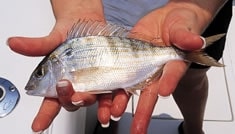
Pinfish are easy to catch off OIB and make excellent live baits for amberjack, cobia and more.|
Inside I was greeted by Rube McMullan, father of the McMullan clan and proud owner of the newest fishing pro shop in the Carolinas. A well-stocked tackle store occupies half the building, while the Giggling Mackerel Restaurant completes the picture. Out back are Brant’s 27-foot center console, the Carolina Contender; the family’s 32-foot Albemarle, the Mac Marle’n; the Captain Hook, a 31 Contender run by local kingfish pro Captain Dave Hooks; Brant’s new 33-foot Gilliken, Show Time, and a couple of shallow-water skiffs.
Over dinner at the restaurant, we discussed the area, and Brant broke out a chart to give me an overview. This stretch of the Carolina coast is blessed with an extensive shelf loaded with high spots, ledges, wrecks and artificial reefs. It holds a variety of game fish, which provide anglers with plenty of light-tackle targets.
In late spring, amberjack, cobia and king mackerel make up the bulk of the nearshore catch in 30 to 70 feet of water. Farther out, 30 to 40 miles offshore in 80 to 120 feet of water, is where you’ll find gag, scamp and red grouper. The shelf is loaded with massive schools of cigar minnows and sardines – snack-foods that attract vacationing species such as king mackerel, sailfish and jacks. In June, when I made my trip, the kings were school-sized, but Brant assured me the big ones were only a couple weeks behind.
| #### OIFC 2004### Tournament ScheduleMay 28-30, 2004: Far-Out Shoot-Out Tuna, dolphin and wahoo tournamentJuly 2 & 3, 2004: Jolly Mon King Mackerel Classic SKA-sanctioned king mackerel tournamentOctober 22 & 23, 2004: Fall Brawl Kingfish Tournament The smokers are in townNovember 26 & 27, 2004: Thanksgiving Flounder & Trout Classic An inshore and back-bay fun event for the whole familyContact Information Ocean Isle Fishing Center 65 Causeway Dr. Ocean Isle Beach, NC 28469 (910) 575-FISH e-mail: info@oifishingcenter.com www.oifishingcenter.com. |
On my first day aboard the Carolina Contender we were joined by Amy, who is as crazy about fishing as the rest of the family. Most days will find her working at the fishing center, but today was her busman’s holiday.
Brant’s plan was to catch live bait and hit a variety of inshore structure no more than 15 miles off the beach. After leaving the inlet, we made a quick stop to jig up some pinfish on No. 5 Sabiki rigs, then headed for the first high spot.
When we arrived, Brant put a block of frozen chum in a mesh bag and tossed it off the transom while we drifted slowly across the top of the rise. The rig for the day consisted of small, bronze treble hooks on a short trace of light, tobacco-colored, single-strand wire. Some had single hooks and others incorporated a second “stinger” hook, which comes in handy when kingfish are on the prowl.
“The kings are pretty abundant in June,” Brant told me, “but they are mostly six- to 15-pound fish. The larger ones move in by early July, about the time we host the Jolly Mon Kingfish Classic, and you never know when you’ll encounter one that runs 30 pounds or better. It doesn’t matter how big they are – if you don’t have wire leaders they’re gone in one quick bite.”
Nearshore Smorgasbord
Light tackle is the rule for kings, even the big ones, so I broke out a seven-foot, nine-inch Rogue graphite trigger stick rigged with a small baitcaster. The reel was loaded with 20-pound super braid ending in five feet of fluorocarbon leader. The first bait wasn’t out more than a few minutes before it was nailed. A few minutes later, Brant grabbed a 12-pound king behind the gills and lifted it into the boat to remove the hook. It was a cute little feller, with its mouth full of teeth, and back he went.
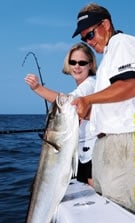
To avoid back and shoulder pain, Amy McMullan limits herself to one amberjack per day!|
After catching a few more kings it was time to hit another spot, this one a wreck in 55 feet of water. No sooner had the chum bag hit the water than a half-dozen barrel-chested fish stormed the boat. AJs! The fish swarmed around the boat like excited puppies waiting for a Milkbone.
Amy got first honors, and as soon as her pinfish hit the water the jacks pounced on it. The lucky winner got to spend the next 20 minutes playing tug-of-war with Amy until she was ready to yell uncle. If you’ve never tussled with a 40-pound-plus amberjack on light tackle, you don’t know what a fish fight is. They don’t know the meaning of the word quit!
“I love these fish,” Amy said after boating the brute, then quickly followed up with, “but not more than one a day!”
Brant put out another bait and immediately hooked a bigger AJ. While he fought the fish, I quietly put down the camera and brought out my fly rod. After a few more live baits were tossed overboard to get the gang wagging their tails again, I was fast to a 40-pounder. Boy, what a mistake! Half an hour into the fight and I still didn’t think I had a chance, but eventually the fish started to tire and I was able to work it to the surface for pictures and a quick release. I decided it was a good time to retire the fly rod.
Amy made it abundantly clear that she didn’t want to pull on any more jacks, and Brant was still on a mission to show me the sights, so it was off to another spot. This time we tried a wreck resting in 60 feet of water, the superstructure visible from the surface.
“Should be cobia on this one,” Brant said, trying not to sound too confident, which is hard when you have a place so wired-in. He has been fishing these waters as a charter captain since he turned 18. At 28, with ten years of guiding and tournament fishing on the Southern Kingfish Association tournament circuit under his belt, Brant earned a reputation for finding fish, as well as being courteous, friendly and extremely professional.
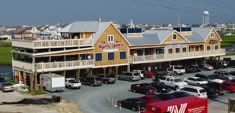
The McMullan clan operates the new Ocean Isle Fishing Center, which shares a building with the Giggling Mackerel Restaurant.|
We fly-lined a couple of pinfish near the surface without raising any interest, so I used a little weight to drop one closer to the wreck. Less than a minute later it was abruptly eaten by something. The fish was strong, pulling line in a bulldog manner, but after a few minutes the telltale brown shape appeared 20 feet below in the clear water, with a couple of its friends tagging along to see what all the fuss was about. Cobia are great fighters and excellent table fare, and it was decided that this one would join us for dinner at the Giggling Mackerel that evening.
The fishing couldn’t have been better, and when I looked at my watch I was surprised to see that it wasn’t even noon! We fished another hour, but when thunderheads appeared on the horizon we called it a day and began focusing on our run to the Gulf Stream the next morning.
The Stream is Smokin’!
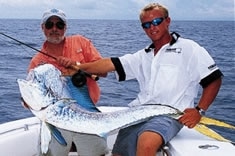
The author, left, gets some help with a bull dolphin that hit a menhaden fly presented with a ten-weight.|
After showing off the great inshore action, Brant wanted me to experience one of the light-tackle offshore activities he’s known for – live-baiting dolphin. Barrett joined us for the run across the shelf to the Gulf Stream, which can be anywhere from 50 to 65 miles offshore; however, before we left we headed east along the beach to load up on menhaden, also known as pogies. Diving pelicans made the chore simple, and soon we were cruising southeast at 35 knots with a couple hundred palm-sized baits in the live wells.
After a little searching we located some scattered weed, a slight temperature break and a developing slick a few miles long. We put out a pattern of small ballyhoo and ran the edges until we hooked a 20-pound dolphin. It was a single fish, so we went on the troll again until we located a school and started chumming them with live pogies. It didn’t take long until we had the school around the boat, ready to eat.
If you’ve only caught dolphin on heavy marlin and tuna gear, you probably weren’t too impressed by the fight. Hook one on medium-action baitcasting tackle, however, and you’ll find out how strong they really are. We battled 15- and 20-pounders that took us all over the boat, burning off line and making spectacular leaps. This is the way dolphin should be caught!
| #### Ocean Isle### Fishing CalendarSpring (mid-March to mid-June) Yellowfin tuna Wahoo Dolphin Blue marlinSummer (mid-June to August) King mackerel Cobia Amberjack Dolphin Blackfin tuna Blacktip shark SailfishFall (mid-September to November) Jumbo king mackerelWinter (December to February) Light-tackle (30 & 50 lb. class) giant bluefin tuna off Morehead City. |
After we had taken a dozen fish, Brant looked at me with a gleam in his eye and said, “Try the fly rod.” On my first cast the fly got hammered, and when I set the hook a huge, green head popped out of the water as if to assess his challenger. Brant looked at me and said calmly, “That’s a big one.”
No kidding. The fight lasted 45 minutes before Barrett was able to gaff the bull – easily the biggest I had ever caught on the fly and a real handful on the ten-weight.
Dolphin fishing just doesn’t get any better than that, but the Stream brings in more than just dolphin to the area. Blue marlin and sailfish are regular visitors, and Brant has been known to live-line small dolphin for the big blues rather successfully. In late winter and early spring, a killer run of yellowfin tuna passes through the area, and these fish are also light-tackle friendly.
Ocean Isle Beach is one of the most underrated fishing destinations I’ve been to in a long time. It’s easy to get to by car from anywhere along the eastern seaboard, the locals are friendly and the launch facilities are plentiful. The Ocean Isle Fishing Center can set you up with everything you need for a successful trip or arrange a charter with one of their fine captains to show you the ropes. However you do it, be ready for some fast action with a variety of species, but don’t skimp on the fly gear.









